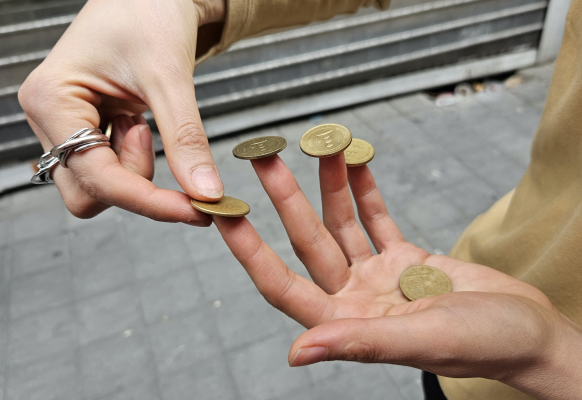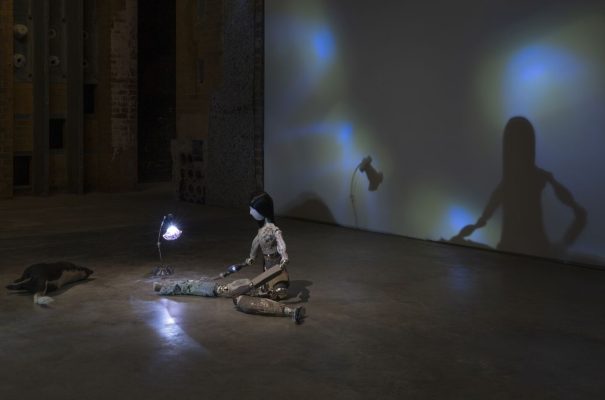
Trained as a painter in Iran, Anita Esfandiari studied drawing, installation, and sculpture at the German art school Städelschule. She’s best known for her depictions and transformations of fountains, which are historical gathering places in her home country.
Check out Esfandiari’s creative evolution at In Practice, which opens at SculptureCenter in Long Island City on Wednesday, Jan. 22, at 6 pm. (The exhibition will then be on view until March 3.)
Admission is free.
Esfandiari’s sculptures engage with diverse mediums, mirroring the inherent socio-political, micro, and macroeconomic conditions that shape everyday reality. For this new show, she created sculptures which juxtapose the materiality of Euro and Iranian Rial coins and highlight the fluctuations and inequality in the two currency values over the last years.
Come, but stay! Two other exhibitions are on display at SculptureCenter, which is located at 44-19 Purves St.
First, Álvaro Urbano – a sculptor, performance artist, and writer critical to New York scenes in the 1970s and 1980s – posthumously displays Tableau Vivant, a piece by sculptor Scott Burton (1939–1989) that was rescued from destruction and now faces an uncertain future, through March 24. The work was originally installed in Midtown Manhattan’s Equitable Center in 1986, but it was dismantled during a 2020 renovation. Attendees can expect to contemplate a semi-circular marble seating area, onyx lamps, a marble centerpiece, plants, and a polished bronze circle delimiting the sculptural plane, all set into a floor inlaid with red granite tiles. It’s all positioned under an illuminated drop ceiling and alongside botanical sculptures in painted metal that reference Central Park’s spring flora in their blooming and decay.
Second, the first institutional exhibition in the United States of artist duo ASMA, Ideal Space for Music, is also at SculptureCenter through March 24. Based in sculpture, ASMA’s works stretch the possibilities of materials such as silicon, resin, bronze, steel, or glass, often blending artisan craft techniques with synthetic and industrial processes. Their research methodology integrates intuitive responsiveness to a site with conceptual explorations found within the arenas of mythology, psychology, and posthumanism, viewed through a metamodern lens.
SculptureCenter, which is dedicated to displaying work by emerging and international artists, was founded as The Clay Club in Brooklyn in 1928. Over the following years, the nonprofit changed its name, moved to a carriage house on West 8th Street in Manhattan, and relocated again to another carriage house on East 69th Street.
In 2001, SculptureCenter purchased its present site, which is near Court Square on the E, M, G, and 7 lines; Queens Plaza on the E, M, and R; and Queensboro Plaza on the 7, N, and W.
Then, Maya Lin, the landscape artist who designed the Vietnam Veterans Memorial in Washington D.C., redesigned it. In 2014, the museum finished a major, multi-million-dollar renovation that added a bookshop, coatroom, seating area, and restrooms to 6,500 square feet of unique exhibition spaces on two levels. The site also has a 1,500-square-foot, enclosed courtyard for outdoor exhibitions.
Editor’s note: In Practice is made possible by the Elaine Graham Weitzen Commissioning Fund for Emerging Artists, which supports the production of new work by artists selected from SculptureCenter’s annual open call. Support for the program also comes from the Pollock-Krasner Foundation with help from the National Endowment for the Arts, Sarah Elson, the Eva Hesse Initiative for New Sculpture, and Lili Forouraghi. Support for all of SculptureCenter’s work with foreign artists is provided by the International Council: Anonymous, Stephen Cheng, Micki Meng, Yan Du, Antonio Murzi and Diana Morgan, Audrey Rose Smith and Vicente Muñoz, Thomas Berger, and Füsun Eczacıbaşı – SAHA.

